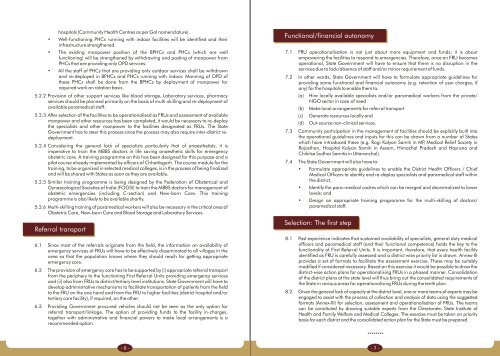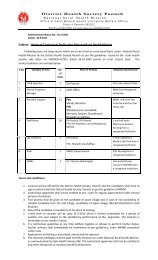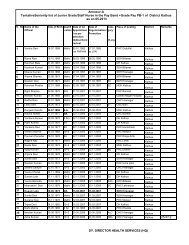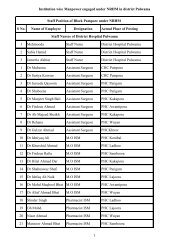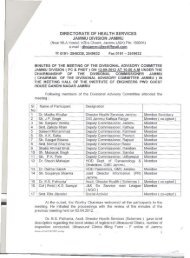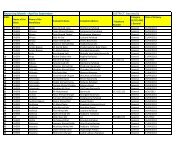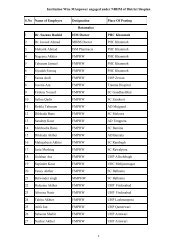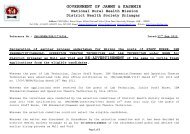Guidelines For Operationalising First Referral Units - National Rural ...
Guidelines For Operationalising First Referral Units - National Rural ...
Guidelines For Operationalising First Referral Units - National Rural ...
Create successful ePaper yourself
Turn your PDF publications into a flip-book with our unique Google optimized e-Paper software.
hospitals (Community Health Centres as per GoI nomenclature).<br />
• Well-functioning PHCs running with indoor facilities will be identified and their<br />
infrastructure strengthened.<br />
• The existing manpower position of the BPHCs and PHCs (which are well<br />
functioning) will be strengthened by withdrawing and posting of manpower from<br />
PHCs that are providing only OPD services.<br />
• All the staff of PHCs that are providing only outdoor services shall be withdrawn<br />
and re-deployed in BPHCs and PHCs running with indoor. Manning of OPD of<br />
these PHCs shall be done from the BPHCs by deployment of manpower for<br />
required work on rotation basis.<br />
5.2.2 Provision of other support services like blood storage, Laboratory services, pharmacy<br />
services should be planned primarily on the basis of multi-skilling and re-deployment of<br />
available paramedical staff.<br />
5.2.3 After selection of the facilities to be operationalised as FRUs and assessment of available<br />
manpower and other resources has been completed, it would be necessary to re-deploy<br />
the specialists and other manpower to the facilities designated as FRUs. The State<br />
Government has to steer this process since the process may also require inter-district redeployment.<br />
5.2.4 Considering the general lack of specialists particularly that of anaesthetists, it is<br />
imperative to train the MBBS doctors in life saving anaesthetic skills for emergency<br />
obstetric care. A training programme on this has been designed for this purpose and a<br />
pilot course already implemented by officers of Chhattisgarh. The course module for the<br />
training, to be organized in selected medical colleges, is in the process of being finalized<br />
and will be shared with States as soon as they are available.<br />
5.2.5 Similar training programme is being designed by the Federation of Obstetrical and<br />
Gynaecological Societies of India (FOGSI) to train the MBBS doctors for management of<br />
obstetric emergencies (including C-section) and New-born Care. This training<br />
programme is also likely to be available shortly.<br />
5.2.6 Multi-skilling training of paramedical workers will also be necessary in the critical area of<br />
Obstetric Care, New-born Care and Blood Storage and Laboratory Services.<br />
<strong>Referral</strong> transport<br />
6.1 Since most of the referrals originate from the field, the information on availability of<br />
emergency services at FRUs will have to be effectively disseminated to all villages in the<br />
area so that the population knows where they should reach for getting appropriate<br />
emergency care.<br />
6.2 The provision of emergency care has to be supported by (i) appropriate referral transport<br />
from the periphery to the functioning <strong>First</strong> <strong>Referral</strong> <strong>Units</strong> providing emergency services<br />
and (ii) also from FRUs to district/tertiary level institutions. State Government will have to<br />
develop administrative mechanisms to facilitate transportation of patients from the field<br />
to the FRU on the one hand and from the FRU to higher facilities (district hospital and/or<br />
tertiary care facility), if required, on the other.<br />
6.3 Providing Government procured vehicles should not be seen as the only option for<br />
referral transport/linkage. The option of providing funds to the facility in-charges,<br />
together with administrative and financial powers to make local arrangements is a<br />
recommended option.<br />
Functional/financial autonomy<br />
7.1 FRU operationalisation is not just about more equipment and funds; it is about<br />
empowering the facilities to respond to emergencies. Therefore, once an FRU becomes<br />
operational, State Government will have to ensure that there is no disruption in the<br />
services due to lack/absence of staff and/or minor requirement of funds.<br />
7.2 In other words, State Government will have to formulate appropriate guidelines for<br />
providing some functional and financial autonomy (e.g. retention of user charges, if<br />
any) for the hospitals to enable them to:<br />
(a)<br />
(b)<br />
(c)<br />
(d)<br />
Hire locally available specialists and/or paramedical workers from the private/<br />
NGO sector in case of need<br />
Make local arrangements for referral transport<br />
Generate resources locally and<br />
Out-source non-clinical services.<br />
7.3 Community participation in the management of facilities should be explicitly built into<br />
the operational guidelines and inputs for this can be drawn from a number of States<br />
which have introduced these (e.g. Rogi Kalyan Samiti in MP, Medical Relief Society in<br />
Rajasthan, Hospital Kalyan Samiti in Assam, Himachal Pradesh and Hayrana and<br />
Chikitsa Sudhar Samitis in Uttaranchal).<br />
7.4 The State Government will also have to:<br />
• <strong>For</strong>mulate appropriate guidelines to enable the District Health Officers / Chief<br />
Medical Officers to identify and re-deploy specialists and paramedical staff within<br />
the district,<br />
• Identify the para-medical cadres which can be merged and decentralized to lower<br />
levels; and<br />
• Design an appropriate training programme for the multi-skilling of doctors/<br />
paramedical staff.<br />
Selection: The first step<br />
8.1 Past experience indicates that sustained availability of specialists, general duty medical<br />
officers and paramedical staff (and their functional competence) holds the key to the<br />
functionality of <strong>First</strong> <strong>Referral</strong> <strong>Units</strong>. It is important, therefore, that every health facility<br />
identified as FRU is carefully assessed and a district wise priority list is drawn. Annex-III<br />
provides a set of formats to facilitate the assessment exercise. These may be suitably<br />
modified if considered necessary. Based on this exercise it would be possible to draw the<br />
district-wise action plans for operationalising FRUs in a phased manner. Consolidation<br />
of the district plans at the state level will thus bring out the consolidated requirements of<br />
the State in various areas for operationalising FRUs during the tenth plan.<br />
8.2 Given the general lack of capacity at the district level, one or more teams of experts may be<br />
engaged to assist with the process of collection and analysis of data using the suggested<br />
formats (Annex-III) for selection, assessment and operationalisation of FRUs. The teams<br />
can be constituted by drawing suitable experts from the Directorate, State Institute of<br />
Health and Family Welfare and Medical Colleges. The exercise must be taken on priority<br />
basis for each district and the consolidated action plan for the State must be prepared.<br />
********<br />
- 6 -<br />
- 7 -


